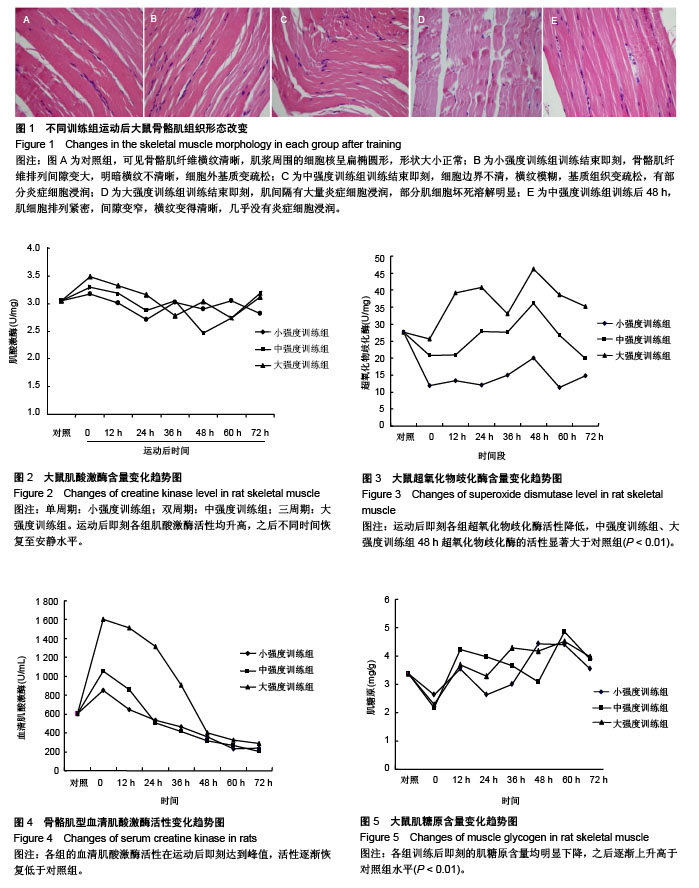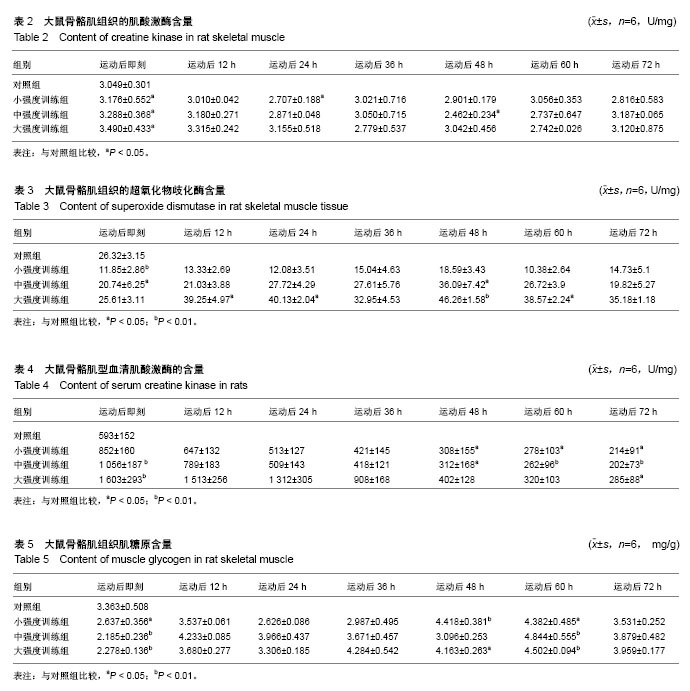中国组织工程研究 ›› 2018, Vol. 22 ›› Issue (24): 3811-3817.doi: 10.3969/j.issn.2095-4344.0274
• 肌肉肌腱韧带组织构建 tissue construction of the muscle, tendon and ligament • 上一篇 下一篇
在糖有氧供能条件下不同强度训练后骨骼肌形态及超量恢复规律的变化
姜 燕1,吴 迪1,武俸羽2
- 1齐齐哈尔大学体育学院,黑龙江省齐齐哈尔市 161000;2哈尔滨体育学院运动科学与健康系,黑龙江省哈尔滨市 150000
Changes in the skeletal muscle morphology and supercompensation after different intensities of training under aerobic energy supply
Jiang Yan1, Wu Di1, Wu Feng-yu2
- 1Institute of Sports of Qiqihar University, Qiqihar 161000, Heilongjiang Province, China; 2Department of Sports Science and Health, Harbin Sport University, Harbin 150000, Heilongjiang Province, China
摘要:
文章快速阅读:
.jpg) 文题释义:
糖有氧供能:是以糖的有氧氧化供能为主的能量代谢过程,该过程需要氧合成ATP,糖被彻底氧化分解而不产生乳酸。
超量恢复规律:指运动时消耗的能源物质以及所降低的各器官系统功能在这段时间内不仅恢复到原来水平,而且会超过原来水平。在一定范围内,运动中消耗的越多,机体恢复的潜能越大,超代偿的现象越明显,采用重复性小周期的训练原则,重复性训练应安排在上一次负荷后的超代偿期间来进行,运动能力会再次得到提高。
文题释义:
糖有氧供能:是以糖的有氧氧化供能为主的能量代谢过程,该过程需要氧合成ATP,糖被彻底氧化分解而不产生乳酸。
超量恢复规律:指运动时消耗的能源物质以及所降低的各器官系统功能在这段时间内不仅恢复到原来水平,而且会超过原来水平。在一定范围内,运动中消耗的越多,机体恢复的潜能越大,超代偿的现象越明显,采用重复性小周期的训练原则,重复性训练应安排在上一次负荷后的超代偿期间来进行,运动能力会再次得到提高。
.jpg) 文题释义:
糖有氧供能:是以糖的有氧氧化供能为主的能量代谢过程,该过程需要氧合成ATP,糖被彻底氧化分解而不产生乳酸。
超量恢复规律:指运动时消耗的能源物质以及所降低的各器官系统功能在这段时间内不仅恢复到原来水平,而且会超过原来水平。在一定范围内,运动中消耗的越多,机体恢复的潜能越大,超代偿的现象越明显,采用重复性小周期的训练原则,重复性训练应安排在上一次负荷后的超代偿期间来进行,运动能力会再次得到提高。
文题释义:
糖有氧供能:是以糖的有氧氧化供能为主的能量代谢过程,该过程需要氧合成ATP,糖被彻底氧化分解而不产生乳酸。
超量恢复规律:指运动时消耗的能源物质以及所降低的各器官系统功能在这段时间内不仅恢复到原来水平,而且会超过原来水平。在一定范围内,运动中消耗的越多,机体恢复的潜能越大,超代偿的现象越明显,采用重复性小周期的训练原则,重复性训练应安排在上一次负荷后的超代偿期间来进行,运动能力会再次得到提高。摘要
背景:超量恢复理论已有一定的发展历程,但骨骼肌在糖有氧供能运动后的“超量恢复”规律的研究则较为鲜见。
目的:通过糖有氧供能条件下不同周期的游泳训练,观察并测定大鼠训练后恢复期的骨骼肌形态结构的变化,以及能源物质和代谢酶的超量恢复规律。
方法:雄性SD大鼠132只按不同训练强度随机分为4组:小强度训练组(42只)、中强度训练组(42只)、大强度训练组(42只)和安静对照组(6只)。将各训练组大鼠先进行1周的适应性游泳,然后按安排进行1周的游泳训练,负重为体质量的6%,大运动量为每组3次,中运动量为每组2次,小运动量为每组1次,每次游泳时间以糖有氧系统供能为主16 min为标准。训练结束取大鼠腓肠肌内侧头进行染色切片,光镜下观察大鼠训练结束后即刻、12,24,36,48,60 和72 h的骨骼肌的形态结构变化,测定腓肠肌中肌糖原、肌酸激酶、超氧化物歧化酶及血清肌酸激酶等指标,并分析糖有氧供能运动后骨骼肌微损伤变化及各指标超量恢复的规律。
结果与结论:①小强度训练组肌糖原在运动后48 h显著高于对照组(P < 0.01),组织与血清肌酸激酶的活性,显著低于对照组(P < 0.05),超量恢复出现在运动后的24-48 h;②中强度训练组肌糖原和超氧化物歧化酶均显著高于对照组(P < 0.01),组织与血清肌酸激酶活性明显低于对照组(P < 0.05),超量恢复在运动后的48-60 h;③大强度训练组的肌糖原在60 h高于对照组(P < 0.05),超氧化物歧化酶在48 h显著高于对照组(P < 0.01),其他指标未出现超量恢复;④结果表明,糖有氧运动结束即刻,中、大强度组的训练使大鼠肌细胞结构出现微损伤,且训练强度越大骨骼肌损伤就越明显;运动后恢复期,中等强度组的骨骼肌形态结构恢复得最好,最佳的时间段在48 h。在糖有氧供能条件下,中等强度训练组的能源物质和有氧酶活性的超量恢复更明显,因此,中等强度的训练模式更适合糖有氧供能型的运动,其超量恢复时间出现在运动后的48-60 h。
中国组织工程研究杂志出版内容重点:组织构建;骨细胞;软骨细胞;细胞培养;成纤维细胞;血管内皮细胞;骨质疏松;组织工程
ORCID: 0000-0002-7709-4004(姜燕)
中图分类号:


.jpg) 文题释义:
糖有氧供能:是以糖的有氧氧化供能为主的能量代谢过程,该过程需要氧合成ATP,糖被彻底氧化分解而不产生乳酸。
超量恢复规律:指运动时消耗的能源物质以及所降低的各器官系统功能在这段时间内不仅恢复到原来水平,而且会超过原来水平。在一定范围内,运动中消耗的越多,机体恢复的潜能越大,超代偿的现象越明显,采用重复性小周期的训练原则,重复性训练应安排在上一次负荷后的超代偿期间来进行,运动能力会再次得到提高。
文题释义:
糖有氧供能:是以糖的有氧氧化供能为主的能量代谢过程,该过程需要氧合成ATP,糖被彻底氧化分解而不产生乳酸。
超量恢复规律:指运动时消耗的能源物质以及所降低的各器官系统功能在这段时间内不仅恢复到原来水平,而且会超过原来水平。在一定范围内,运动中消耗的越多,机体恢复的潜能越大,超代偿的现象越明显,采用重复性小周期的训练原则,重复性训练应安排在上一次负荷后的超代偿期间来进行,运动能力会再次得到提高。